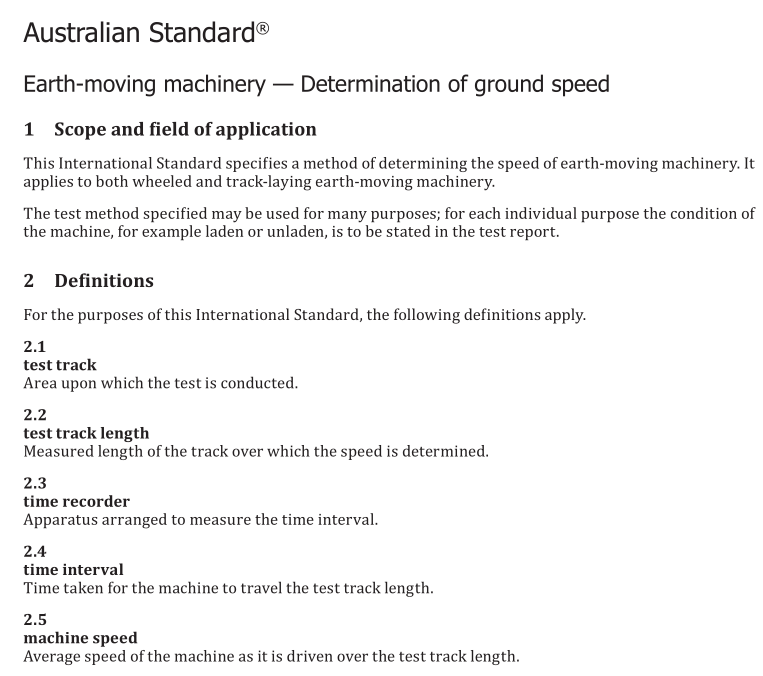AS ISO 6014 pdf download – Earth-moving machinery — Determination of ground speed

AS ISO 6014 pdf download – Earth-moving machinery — Determination of ground speed
1 Scope and field of application
This International Standard specifies a method of determining the speed of earth-moving machinery. Itapplies to both wheeled and track-laying earth-moving machinery.
The test method specified may be used for many purposes; for each individual purpose the condition ofthe machine, for example laden or unladen, is to be stated in the test report.
2Definitions
For the purposes of this International Standard, the following definitions apply.2.1
test track
Area upon which the test is conducted.2.2
test track length
Measured length of the track over which the speed is determined.2.3
time recorder
pparatus arranged to measure the time interval.2.4
time interval
Time taken for the machine to travel the test track length.2.5
machine speed
Average speed of the machine as it is driven over the test track length.2.6
test speed
Mean value of the average speeds recorded in the individual tests.2.7
mass
Mass of the machine in the condition in which it is tested, including the mass of the operator and fuel.
3Apparatus
Any equipment may be used to measure the speed of the machine provided that the accuracies specifiedin clause 5 are achieved.For example, the following equipment may be used (see the figure).
3.1 Light source,used to activate a photo-sensitive transistor. lt may be an electric lamp fed by abattery. generator or mains supply.
3.2Control box, linked to the photo-sensitive transistor and the electronic digital display timer,incorporating a switch to permit time measurements in either direction.
3.3 Electronic digital display timer (otherwise referred to as the variable time base counter),used tomeasure the time interval during which the machine under test traverses the test lengths of the track.NOTE— Alternatively,the time may be measured with stop-watch equipment.
3.4 Electrical supply, which may be a direct current supplied by batteries, when an inverter is required to produce an alternating current from a direct current electrical supply. Alternatively, a mains alternating current may be used. 3.5 Tape measure, at least 25 m in length, to determine the test track length. 3.6 Adjustable tripods, to support all light sources and photo-sensitive transistors at the same height. 4 Test conditions The test may be carried out on any type of track but the test track length shall be a minimum of 20 m and in any case of sufficient length to be compatible with the speed of the machine being tested. Since the apparatus used in the test can be completely portable, it is possible to make speed measurements on gradients, on natural ground and on normal road surfaces in any condition. The time recorder shall be set up in such a way that the machine under test has a sufficiently long approach route to the test length in which to gain the speeds required, and enough room to brake, turn around and, if required, undergo a test in the opposite direction. The test track and machine conditions shall be as specified in the appropriate standard (for example, ISO 3450: for braking tests which require a knowledge of the speed of the machine, the conditions shall be as required in the Standard). For level test tracks, the difference in height between any two points not less than 25 m apart along the test track shall not exceed 100 mm. The cross-fall for all test tracks shall not exceed 1 in 40. Immediately prior to the test, the machine shall be run for a period sufficient to ensure that the engine, transmission, oils and coolant are at normal working temperatures. 5 Procedure The machine, prepared as required, shall be driven towards the test area at a constant speed and shall be driven through the test track length without any change on the throttle setting or gear. It shall be driven in a direction parallel to the longitudinal axis of the test length of the track. The time interval for a point on the machine to traverse the test track length shall be recorded. The test shall be carried out not less than three times in each direction if the track is level, and not less than six times in one direction if the speed on a gradient is to be determined. The maximum wind speed for tests in one direction shall be 6 m/s. The average machine speed over the test track length shall be calculated for each individual test and the mean value of all the speeds calculated and reported as the test speed.









